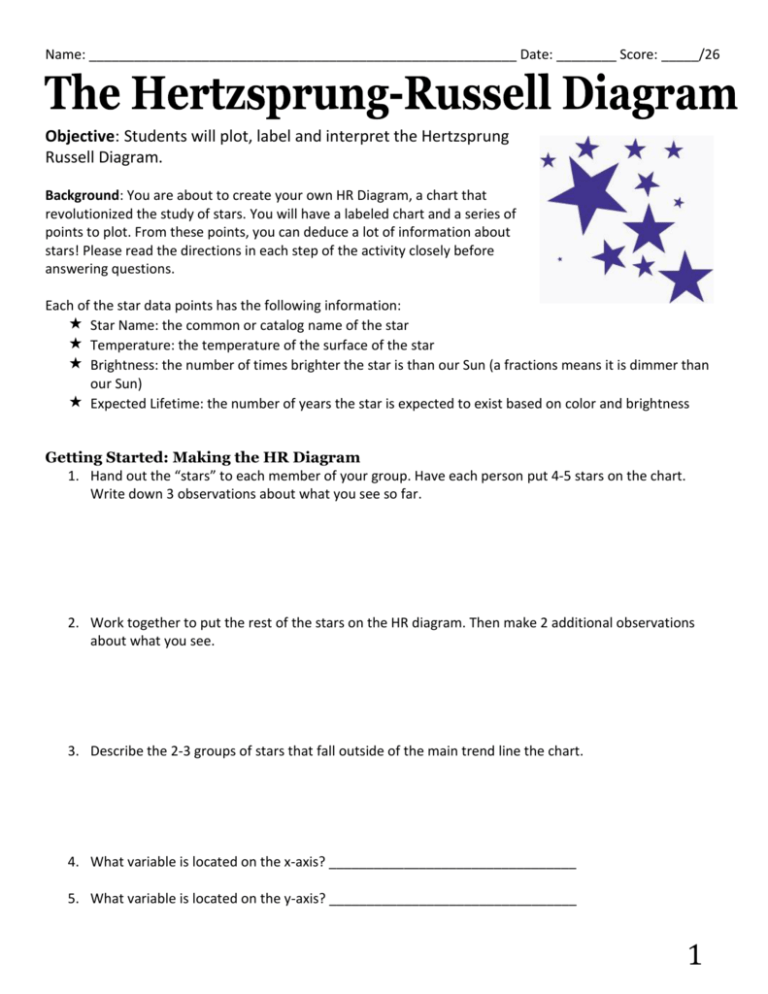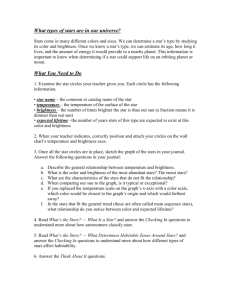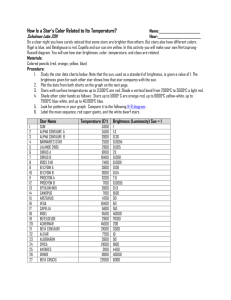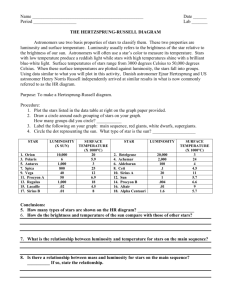HR Diagram Lab Handout
advertisement

Name: _________________________________________________________ Date: ________ Score: _____/26 Objective: Students will plot, label and interpret the Hertzsprung Russell Diagram. Background: You are about to create your own HR Diagram, a chart that revolutionized the study of stars. You will have a labeled chart and a series of points to plot. From these points, you can deduce a lot of information about stars! Please read the directions in each step of the activity closely before answering questions. Each of the star data points has the following information: Star Name: the common or catalog name of the star Temperature: the temperature of the surface of the star Brightness: the number of times brighter the star is than our Sun (a fractions means it is dimmer than our Sun) Expected Lifetime: the number of years the star is expected to exist based on color and brightness Getting Started: Making the HR Diagram 1. Hand out the “stars” to each member of your group. Have each person put 4-5 stars on the chart. Write down 3 observations about what you see so far. 2. Work together to put the rest of the stars on the HR diagram. Then make 2 additional observations about what you see. 3. Describe the 2-3 groups of stars that fall outside of the main trend line the chart. 4. What variable is located on the x-axis? _________________________________ 5. What variable is located on the y-axis? _________________________________ 1 6. Fill in the following chart with information from the stars on the chart. Color Dark Blue Temperature (K) Brightness Lifetime Light Blue Yellow Orange Red Color (6 points) 7. The temperature of the hottest stars is _______________. 8. The color of the hottest stars is ________________. 9. The temperature of the coldest stars is _______________. 10. The color of the coldest stars is ________________. 11. The life expectancy of a very hot star is _______________ years. 12. The life expectancy of a very cold star is _______________ years. Magnitude (6 points) 13. The temperature of the brightest stars is _______________. 14. The color of the brightest stars is ______________. 15. The temperature of the dimmest stars is ______________. 16. The color of the dimmest stars is _______________. 17. The life expectancy of a very bright star is _______________ years. 18. The life expectancy of a very dim star is _______________ years. Fusion (2 points) 19. Look up the word fusion in your textbook and define it in your Glossary. Explain why the hottest, brightest stars have a very different life expectancy from the coldest, dimmest stars. 2 Labeling the HR Diagram 1. Take a look at 4 red stars from different parts of the HR Diagram. Record their information in the chart at right. Star Name Brightness Temperature (K) 2. Describe the differences between the stars (2 points). 3. Use your textbook to define the following terms in your Glossary: Main sequence, red giant, supergiant, and white dwarf. 4. Now that you have completed constructing and labeling the HR Diagram, add COLOR to the chart below. 3 Conclusion Questions Directions: Answer the following questions in 2-3 complete sentences. Be sure to address all aspects of the question. 1.) What is the relationship between temperature/color and brightness in the HR Diagram (2 points)? 2.) What is the relationship between temperature/color and expected lifetime? Which stars will die first and why? (2 points) 3.) Explain how we know that there are red giants and supergiants on the HR Diagram (HINT: Refer to questions 1 and 2 on page 3) (2 points). 4.) Compare and contrast the Sun and Antares in terms of brightness, color and temperature using the diagram on the previous page (3 points). 5.) Explain in 1-2 sentences what the Hertzsprung-Russell diagram shows (1 point). 4








